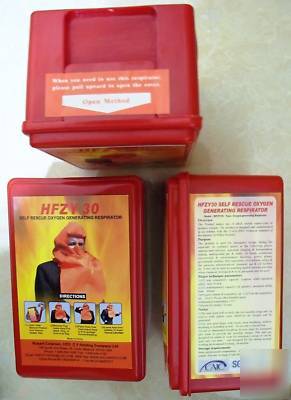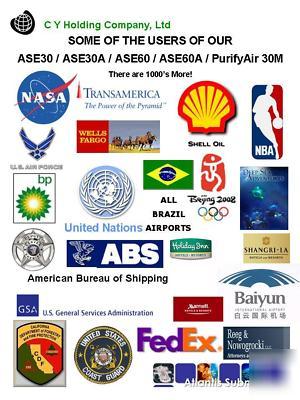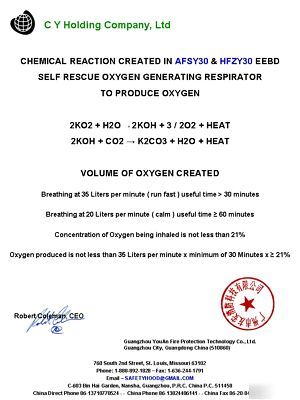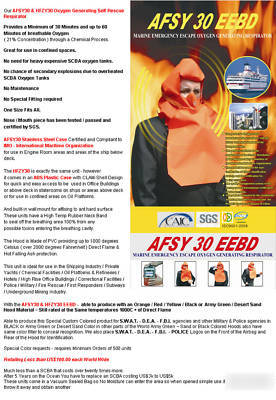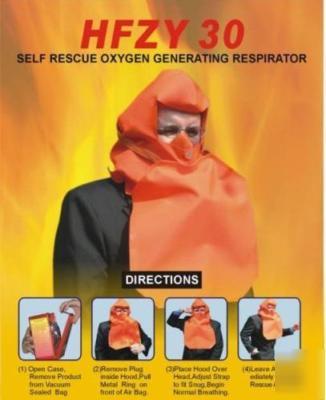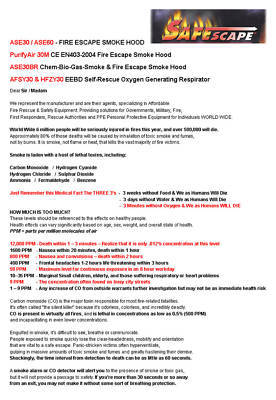Tristate Machinery Dismantlers Forum > INDIANA
> Electrical Components
> Used
> Without Warranty
> HFZY30 eebd self rescue respirator
HFZY30 eebd self rescue respirator
Do You Know this Medical Fact about We as Humans Ask Any Doctor to Verify this
- 3 weeks without Food and We as Humans Will Die
- 3 days without Water and We as Humans Will Die- 3 Minutes without Oxygen and We as Humans WILL DIE
PROTECTS YOU AGAINST ALL ~ CHEMICAL - BIOLOGICAL - GAS - SMOKE & FIRE
Easy to carry in your Bag when Flying or traveling
Provide up to 60 Minutes of Breathable Air ( 21% CONCENTRATION )
These are closed Systems - similar to an SCBA used by Firemen
Our HFZY30 EEBD Self Rescue Respirator provides
a Minimum of 30 Minutes and up to 60 Minutes of breathable Oxygen ( 21% Concentration )
through an exothermic chemical process.
+ Great for use in confined spaces +
+ No need for heavy expensive oxygen tanks +
+ No chance of secondary explosions due to overheated Oxygen Tanks +
+ No Special Fitting required +
+ Nose / Mouth piece has been tested / passed and certified by SGS +
This same Nose / Mouth Piece is used on ALL of our products.
Our AFSY30 Stainless Steel Case required by IMO - International Maritime Organization
The HFZY30 is exactly the same unit - however - it comes in an ABS Plastic Case with CLAM-Shell Design
or areas above deck or for use in confined areas on Oil Platforms.
These units have a High Temp Rubber Neck Band to seal off the breathing area 100% from any
The Hood is Made of PVC providing up to 1000 degrees Celsius ( over 2000 degrees Fahrenheit )
Direct Flame & Hot Falling Ash protection.
Great for use in confined spaces.
High Rise Office Buildings and by Correctional Facilities / Police / Fire Rescue / First Responders
Retailing at only US$180.00 much less than a SCBA
which costs over twenty times more.
WE HAVE 1000's of these units available for immediate delivery
Warning Signs of A CHEMICAL - BIOLOGICAL - GAS Attack or Incident
A chemical or biological attack or incident won't always be immediately apparent given the fact that many agents are odorless and colorless and some cause no immediately noticeable effects or symptoms.
Be alert to the possible presence of agent. Indicators of such an attack include:
* Droplets of oily film on surfaces
* Unusual dead or dying animals in the area
* Unusual liquid sprays or vapors
* Unexplained odors (smell of bitter almonds, peach kernels, newly mowed hay, or green grass)
* Unusual or unauthorized spraying in the area
* Victims displaying symptoms of nausea, difficulty breathing, convulsions, disorientation, or patterns of illness inconsistent with natural disease
* Low-lying clouds or fog unrelated to weather; clouds of dust; or suspended, possibly colored, particles
* People dressed unusually (long-sleeved shirts or overcoats in the summertime) or wearing breathing protection particularly in areas where large numbers of people tend to congregate, such as subways or stadiums
Our HFZY30 EEBD SELF RESCUE RESPIRATOR protects you against Carbon Monoxide (CO) /
Hydrogen Cyanide (HCN) / Hydrogen Chloride / ( HCL) Acrolein ( CH2CHCHO ) / Hydrocyanic Acid /
Hydrogen Arsenide Phosgene / Diphosgene / Chlorpicrin / Pestmaster / Dichloromethane /
Lewsite Gas / Mustard Gas / Sarin / Benzene / Chlorine / Acetone / Alcohol Class / Aniline class / Carbon Disulphide /
Carbon Tetrachloride / Cloroform / Methyl Bromide Chlorotoluene, Nitroalkaline / Ammonia Gas /
Suphur Dioxide / Chlorine Gas / Hydrogen Sulphide / Oxides of Nitrogen Phosgene /
Phosphorate or Chlorine organoagricultural chemicals / Radioarerosol / Bacteria aerosol and
other Toxic Smoke - Fog - Dust and Gases.
HARD CASE Measures 4.25 x 5.75 x 8.5 inches
Is secure in Vacuum Sealed Bag and has Security Label on top of Case
The Silent Killer Carbon Monoxide - - How much CO is too much? What you should know to protect your family from The Silent Killer? CO poisoning from the use of fuel burning appliances kills hundreds people each year and sends more than 50,000 to hospital emergency rooms for treatment. Others die from CO produced while burning charcoal inside a home, garage, vehicle or tent.
Still others die from CO produced by cars unintentionally left running in attached garages." *CPSC 1997
Carbon monoxide (CO) is an odorless and colorless gas which could be created whenever a fuel (such as wood, gasoline, coal, natural gas, kerosene, etc.) is burning. You may be exposed to Carbon Monoxide when: You leave your car, truck or van running. You burn charcoal, alcohol or gasoline in an enclosed test, camper or room. You smoke a cigar, cigarette or pipe. You home contains an incorrectly vented or malfunctioning hot water heater, furnace, space heater, fireplace or stove.
How does Carbon Monoxide harm you?
Quite simply, carbon monoxide prevents oxygen from being used by your body.
Carbon monoxide is poisonous and can harm your central nervous system.
Everyone is at risk of being poisoned by carbon monoxide.
However, individuals with existing health problems such as heart and lung disease and the elderly are especially vulnerable.
Infants, children and pregnant women are also at risk. How much CO is too much? The health effects can vary significantly due to age, sex, weight and overall state of health.
CO is measured in Parts per Million or PPM; out of a million molecules of air, how many are carbon monoxide.
The time given respective to the levels referenced in this chart, are for healthy people unless otherwise stated.
Just Remember this Medical Fact THREE 3 s - 3 weeks without Food and We as Humans Will Die - 3 days without Water and We as Humans Will Die - 3 Minutes without Oxygen and We as Humans WILL DIE
HOW MUCH - CO ( CARBON MONOXIDE ) IS TOO MUCH?
These levels should be referenced to the effects on healthy people.
Health effects can vary significantly based on age, sex, weight, and overall state of health.
PPM = parts per million molecules of air
12,000 PPM - Death within 1 3 minutes Realize that it is only .012% concentration at this level
1600 PPM - Nausea within 20 minutes, death within 1 hour
800 PPM - Nausea and convulsions death within 2 hours
400 PPM - Frontal headaches 1-2 hours life threatening within 3 hours
50 PPM - Maximum level for continuous exposure in an 8 hour workday
10 35 PPM - Marginal Small children, elderly, and those suffering respiratory or heart problems
9 PPM - The concentration often found on busy city streets
1 9 PPM - Any increase of CO from outside warrants further investigation but may not be an immediate health risk
Carbon monoxide (CO) is the major toxin responsible for most fire-related fatalities.
It's often called "the silent killer" because it's odorless, colorless, and incredibly deadly.
CO is present in virtually all fires, and is lethal in concentrations as low as 0.5% (500 PPM)
and incapacitating in even lower concentrations.
Engulfed in smoke, it's difficult to see, breathe or communicate.
People exposed to smoke quickly lose the clear-headedness, mobility and orientation
that are vital to a safe escape. Panic-stricken victims often hyperventilate,
gulping in massive amounts of toxic smoke and fumes and greatly hastening their demise.
Shockingly, the time interval from detection to death can be as little as 60 seconds.
A smoke alarm or CO detector will alert you to the presence of smoke or toxic gas,
but it will not provide a passage to safety. If you're more than 30 seconds or so away
from an exit, you may not make it without some sort of breathing protection.
How Fires Produce Cyanide John P. Benner, NREMT-P, David Lawrence, DO, , William Brady, MD Oct 1, 2009
Every 20 seconds, a fire department responds to a fire somewhere in the U.S. Whether these are "wildland" (forest or brush) or structure (house or industrial) fires, the potential for toxin production is very high. When items burn, they release lethal chemicals, and household items - such as carpeting, electronics, beds/mattresses and cleaning supplies - can be particularly deadly because of the cyanide they produce during combustion. In fact, the household setting is where EMS providers will most frequently encounter cyanide. To learn why cyanide and other toxins are released during the combustion process and why they're so harmful, we turn to some basic science concepts:
Concept #1: The process of combustion is nothing more than a basic oxidation chemical reaction.
This reaction often involves adding oxygen (O2) to a substance at a certain temperature,
which allows it to burn, yielding carbon dioxide (CO2) and water (H2O) as the primary products.
Concept #2: Every substance on Earth, from dirt to nylon, is made up of either organic or inorganic molecules.
Organic molecules contain differing numbers of only carbon (C) and hydrogen (H) atoms.
Inorganic molecules contain other elements, such as nitrogen (N), in addition to carbon and hydrogen.
Many organic and inorganic substances become fuel and burn when exposed to high temperatures.
When a substance (or fuel) burns (or oxidizes), the chemical make-up of the fuel is determines the products that will form.
The following figure corresponds to the basic chemical reaction for the combustion of an organic substance;
Using this basic formula, an example of an organic hydrocarbon would allow the X=3 and the Y=8, giving the chemical formula for propane gas, C3H8.
Theoretically, if the fuel being completely oxidized, such as propane, is organic, then carbon dioxide and water will be the only products. On the other hand, in the case of the oxidation of an inorganic molecule, other chemicals can potentially be produced.
Take nitrogen (N), for example; consider the generic chemical equation for the combustion of nitrogenous compounds:
CxHyNz + O2 = CO2 + H2O + HCN or Nitrogenous Fuel + Oxygen = Carbon dioxide + Water + Cyanide CxHyNz is a generic chemical formula of a nitrogenous compound, or one that contains nitrogen.
Using this basic formula, an example of a nitrogenous compound would allow X=2, Y=3 and Z=1 to form acetonitrile, or C2H3N.
Nitrogen is a typical element combined with carbon and hydrogen in many types of substances,
especially natural polymers (i.e., wool and silk) and synthetic fibers (i.e., nylon and polyurethane).
In addition, nitrogen is a major component of the atmospheric air that we breathe.
When burned, nitrogen-containing products carry the significant potential to form between carbon, nitrogen and hydrogen directly.
Depending on the numbers of each element present in the reaction or the level of completion of the combustion reaction, the product could potentially form as HCN,
otherwise known as hydrogen cyanide.(2)
There's no fighting these natural processes; there are only antidotes for patients who fall victim to the dangers of combustion.
We are an international manufacturer with offices located in St. Louis, Missouri USA and
Guangzhou, China specializing in Affordable Fire Rescue & Safety Equipment as well as
CCTV / X-RAY Security / Tactical Body Armor / LED Batons - Billboards - Lighting - Flashlights
/ Solar / Wind Powered Green Energy Solutions.
Providing solutions for Governments, Military, Fire, First Responders, Rescue Authorities
and PPE Personal Protective Equipment for Individuals WORLD WIDE.
We look forward to becoming partners in Saving Lives
We hope we can work together as partners in Saving Lives.
+ Provides the user with 30 Minutes of Filtered Breathable Air
+ These Units Have a Shelf Life of 4 years from Date of Manufacture.
We are the international manufacturers and agents with offices located in St. Louis,
Missouri USA and Guangzhou, China, specializing in Affordable Fire Rescue & Safety Equipment.
We provide solutions for Governments, Military, Fire, First Responders, Rescue Authorities
WE WILL OFFER ALL OF YOU THE SAME PRICE ON THIS LIFE SAVING PRODUCT
LOOK AT THE PHOTO ATTACHED OF JUST SOME OF THE USERS
